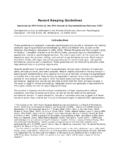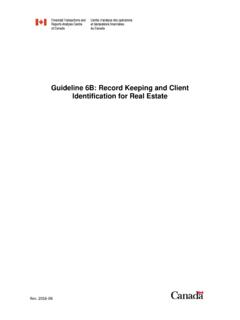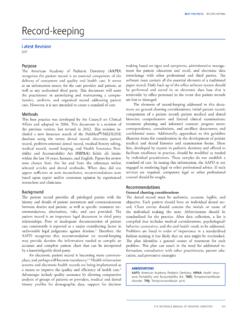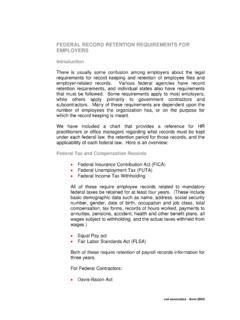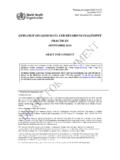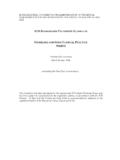Transcription of Dental Recordkeeping Guidelines - CDSBC
1 Dental Recordkeeping GuidelinesApril 2013 Contents 2 Introduction 4 Medical and Dental History 5 Confidentiality 6 Dental Examination 8 Informed Consent 9 Treatment Records 10 Electronic Recordkeeping 11 Financial Records 12 Drug Records 13 Ownership, Retention, Transfer and Disposition of Dental RecordsPractice Guidelines of the College of Dental Surgeons of BC ( CDSBC ) should be considered by all dentists and certified Dental assistants in the care of their patients. It is the responsibility of all practitioners to maintain accurate patient records as recommended in this document.
2 It is important to note that these Guidelines may be used by CDSBC or other bodies in determining whether professional responsibilities and appropriate standards of practice have been , ethical and legal responsibilities dictate that a complete chart and record documenting all aspects of each patient s Dental care must be maintained. Good records facilitate the provision of effective clinical care and ensure the continuity and comprehensiveness of oral/ Dental health records must be accurate, well-organized, legible, readily accessible and understandable. If the practitioner of record were for any reason to become unable to practise, another dentist should be able to easily review the chart and carry on with the care of the Guidelines are designed to provide assistance to practitioners and comfort to the public that Dental patient information is both accurate and ManagementIn recent years, the requirements for Dental records management have been redefined, especially as they relate to documentation, release of information and storage.
3 Dentists are expected to be familiar with current expectations and to ensure that their staff members understand and adhere to the updated of this DocumentThese Guidelines are designed to help practitioners meet legal requirements for Dental Recordkeeping . They also have application in several areas of responsibility of the CDSBC regarding standards of practice and quality assurance. The statutory committees of CDSBC that consider allegations of professional misconduct the Inquiry and Discipline Committees may use this document as a reference when considering a particular is important, therefore, that dentists and CDAs carefully read this document and take the necessary action to ensure that their Dental Recordkeeping complies with the recommendations contained in these Guidelines .
4 Once a practitioner has determined that the Dental record form being used allows for the collection and retention of the required patient information, all that is required is that the records be kept and updated each time there is contact with a patient. It is the CDSBC s opinion that practice Guidelines should be sufficiently flexible to allow practitioners to exercise their judgment with respect to particular situations. Accordingly, the terms appropriate and pertinent have been used throughout these Guidelines to indicate where professional judgment is expected. Purposes of RecordsA Dental record should provide an accurate picture of the patient s general health, as well as oral/ Dental status and any patient concerns and requests.
5 It should include the proposed treatment plan and any treatment performed, as well as all supporting documentation. Outcome of treatment should be documented and any deviations from expected outcomes should be recorded on the patient chart at the time of service. Patients should be advised of compromised results as soon as the dentist is aware of the situation. All relevant information presented to the patient should be Assumptions Patients have a right to expect that their Dental health information will be kept confidential. Patients have a right (with a few exceptions) to review and obtain a copy of their Dental records including consultation reports of other Recordkeeping Guidelines It is appropriate, where patient consent has been obtained, to share Dental and medical records with other health professionals as necessary to ensure continuity and quality of care.
6 Every Dental team member involved in a patient s care should maintain the confidentiality and security of a patient s Dental records, only sharing them with other health care professionals for the purpose of assisting in providing optimal care. Dental records should only be disposed of in a manner that ensures that the confidentiality of the information is of RecordkeepingThe extent of detail required for each record will vary, however, certain baseline data should be common to all Dental information includes: accurate general patient information; a medical history that is periodically updated; a Dental history; an accurate description of the conditions that are present on initial examination, including an entry such as within normal limits where appropriate; an accurate description of ongoing Dental status at subsequent appointments.
7 A record of the significant findings of all supporting diagnostic aids, tests or referrals such as radiographs, study models, reports from specialists; all clinical diagnoses and treatment options; a record that all reasonable treatment planning options were discussed with the patient; the proposed and accepted treatment plan; a notation that informed consent was obtained; assurance that patient consent was obtained for the release of any and all patient information to a third party; a description of all treatment that was performed, materials and drugs used and, where appropriate, the prognosis and outcome of the treatment; details about referrals; and an accurate financial Recordkeeping PrinciplesIn keeping and maintaining acceptable patient records, a prudent practitioner would adhere to the following principles: All entries should be dated and recorded by hand in permanent ink or typewritten, or be in an acceptable electronic format and be complete, clear and legible.
8 All entries, including electronic entries, should be signed, initialled or otherwise attributable to the writer and if different, the treating clinician. Radiographs and other diagnostic aids, such as study models, should be properly labelled, dated and the interpretation of the findings documented when considered appropriate by the practitioner. An explanation of the overall treatment plan, treatment alternatives, any risks or limitations of treatment and the estimated costs of the treatment should be provided to each patient, parent, legal guardian or government-appointed advocate as appropriate. This fact should be noted in the patient record .
9 In complex or difficult cases, it is advisable to have such informed consent Patient InformationIt is important that patient records contain the following general information for every patient and that this information be updated at regular intervals. Information should include the patient s name, contact information, date of birth, primary care physician, emergency contact name and number, and insurance information, if HistoryA general medical history should be reviewed and initialled by the treating practitioner and dated at the initial examination. The information should be updated regularly based on the patient s age and history and the update noted in the patient taking a medical history, dentists must ensure that all necessary and relevant medical information is obtained in order to allow for the provision of safe Dental care at the time of treatment and in the future.
10 It is important that the collection of necessary medical history information be done in a systematic manner. In determining, for example, if a patient has had any serious illnesses, conditions or adverse reactions that might impact on the provision of safe Dental care, the following checklist may be helpful: details of past hospitalizations and/or serious illnesses, conditions or adverse reactions; significant respiratory diseases, asthma, emphysema, tuberculosis; any known allergies; peculiar or adverse reactions to any medicines or injections, penicillin, Aspirin or local anaesthetics; heart disease, heart attack, blood pressure problems or stroke; history of infective endocarditis; epilepsy or seizures.

